West African country lost 4.4 percent of forests in 12 years, new incentives may help stymie future destruction
Liberia is one of the last strongholds of intact forest in West Africa. These forests are the home of many unique species of plants and animals. They are important for human communities, as well. Many Liberians rely on the forests for direct economic benefits, and the presence of intact forests may even be important for preventing the future outbreak of disease such as Ebola, which can be transmitted to people from animal vectors displaced by deforestation.
According to data from the forest monitoring site Global Forest Watch, Liberia lost nearly 400,000 hectares of forest from 2001 through 2012 – or about 4.4 percent of its total tree cover. Even the country’s protected areas are not immune to deforestation. For instance, a protected area in the northwest portion of the country lost 12 percent of its forest cover between 2001 and 2013.
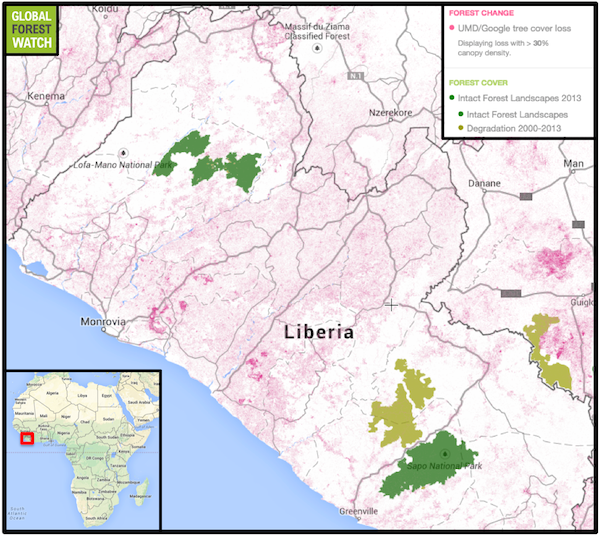
Liberia lost approximately 400,000 hectares of tree cover from 2001 through 2012, at an average rate of 9,000 hectares per year. During this time, 2009 saw the highest annual amount at more than 75,000 hectares. Since 2000, the country’s amount of intact forest has declined by about a third, with Sapo National Park encompassing one of the remaining large tracts (lower right). Map and data courtesy of Global Forest Watch. Click to enlarge.
Liberia’s forests are home to many unique and threatened animal species. These forests are one of the last strongholds for the pygmy hippopotamus (Choeropsis liberiensis or Hexaprotodon liberiensis), the smaller cousin of the Nile hippopotamus (Hippopotamus amphibius). There are perhaps only 2,000 individuals remaining in the wild and it is listed as Endangered on the IUCN Red List. Some 14 species of primates live in the forests of Liberia, including one of the last populations of western chimpanzees (Pan troglodytes verus). A remnant population of elephants Loxodonta africana persists in Liberia, but poaching in the 1980s eliminated 95 percent of the country’s elephants.
The forests of Liberia are part of the Upper Guinean Forest biodiversity hotspot, one of the areas of highest biological diversity on Earth.
“Liberia is the main center of endemism in West Africa (west of south-east Nigeria),” said Carel Jongkind, an expert on the botany of Liberia. “The list of Liberian endemics is not really long, but if you include all species that have their main foothold in Liberia then the list is much longer (because the center of endemism just crosses borders with Ivory Coast, Guinea and Sierra Leone). If Liberia is gone, then these species will go quickly extinct in these other countries as well. We collect new real Liberian endemic species with every expedition to the forest there.”
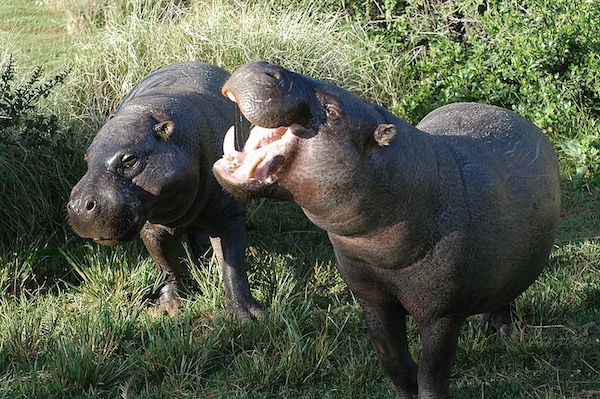
Liberia is home to pygmy hippos (Choeropsis liberiensis or Hexaprotodon liberiensis), which are listed by the IUCN as Endangered.
In addition to wildlife habitat, Liberia’s forests provide valuable resources for human communities.
“In Liberia even today a lot of people in the country get part of their livelihood from the forest,” Jongkind said. “New slash and burn farms and single oil palms (no plantations) and Raphia palms (palm wine) in the forest and bush meat are very important. Most building material in the villages still comes straight from the forest. A lot of seeds and fruits are eaten. In bad times (war) people can still live from the forest. Everywhere there is small scale palm oil processing by local women when you walk through the country.”
In an article published by Fauna and Flora of Liberia, Alice Ramsey and Phillip Robinson document that there is a long history of forest conservation in Liberia. Legislation in 1953 laid the foundation for the establishment of national parks and forest reserves. The first national park, Sapo National Park, was established in 1982 to protect 697 square miles (1,805 square kilometers) of rain forest, the second largest intact tract of forest remaining in West Africa.
A series of wars beginning in 1989 disrupted nature conservation activities in Liberia and actively threatened Sapo National Park, with illegal logging, gold mining, and bush meat hunting infiltrating the once-protected forest. Harvesting of Liberia’s trees for the timber market was practiced on a large scale to finance the wars, according to Ramsey and Robinson.
In 2003 the Liberian government pledged to protect 30 percent of its remaining forest areas for conservation and established its second protected area, the East Nimba Nature Reserve. A report by the forest protection advocacy group Global Witness documented that logging companies were covertly using a method called Private Use Permits to gain control of 40 percent of Liberia’s remaining forests. Private Use Permits were intended as legal methods for farmers to legally remove trees for agriculture, but were turned into a de facto method for logging interests to circumvent protected areas.
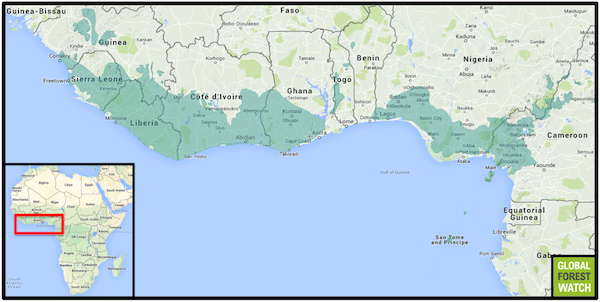
The Guinean Forests (blue) extend along the West African coast. The region is a biodiversity hotspot, meaning it is home to a high number of unique species and is particularly threatened by human activities. Map courtesy of Global Forest Watch. Click to enlarge.
Ongoing logging operations, mining, and illegal hunting continue to threaten the forests of Liberia, both inside and outside protected areas.
“Sometimes the infrastructure (roads, new village for the laborers, etc.) outside the concession is more damaging than the concession itself,” Jongkind said. “Even Sapo [National Park] and Lake Piso are almost permanently threatened. It took a lot of time and energy to get the gold diggers out of Sapo. At the same, a large part of the country’s population, away from the few cities, still need the forest for their livelihood.”
Last month, the government of Norway announced a partnership with the government of Liberia to stop the logging of Liberia’s forests. The partnership seeks to expand protected forest areas and to reform laws that are exploited to circumvent logging restrictions, such as the misuse of Private Use Permits.
According to Jongkind, the expansion of Liberia’s network of protected areas is much needed.
“There are not at all enough protected areas in Liberia to save even a part of the biodiversity richness of the country,” Jongkind said. “And it will not take long before there are no possible new areas for protection left. Everywhere there are new mines, palm oil plantations, roads and railroads or logging concessions planned or already in place. A new mine is one thing, but you need to connect it with a (new) harbor at the coast.”
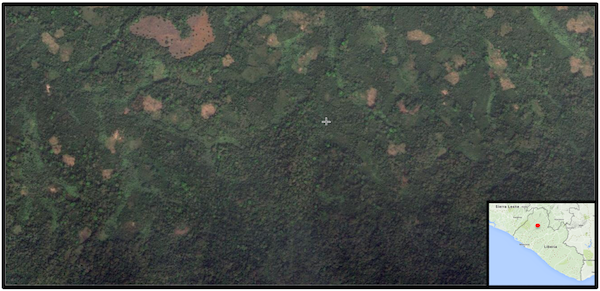
Satellite imagery of deforestation pock-marking the landscape near Lofa-Mano National Park. Image courtesy of Global Forest Watch/Google Earth. Click to enlarge.
Preservation of biodiversity and forest resources isn’t the only reason for halting deforestation in Liberia. Currently, the country has been at the epicentre of the worst outbreak of the Ebola virus in recorded history, leaving over 4,000 people dead as of October and with no foreseeable end in sight. Scientists suspect the main vector of the Ebola virus to be fruit bats. As forests are felled, the influx of humans into bat habitat and the displacement of bats into human settlements may put people at risk of animal-borne diseases – such as Ebola.
The authors of a 2012 review of Ebola outbreaks in Africa concluded that extensive deforestation and human activities in the depth of the forests may promote contact between humans and natural reservoirs of the Ebola virus. They write that reducing deforestation and effective protection of forest areas could be important in preventing future outbreaks of the Ebola virus in Liberia and the surrounding region.
Related articles
Tigers vs. diamonds: India’s protected areas rampantly downgraded to make room for people, industry (PART II)
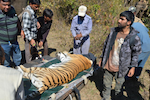
(10/29/2014) In India’s central state of Madhya Pradesh lie 500 square kilometers (200 square miles) of protected land demarcated as the Panna Tiger Reserve. Recently, however, its protection status has been questioned, and global-scale analyses show Panna is far from alone among India’s many threatened Protected Areas.
World’s rarest gorilla gets a new protected home
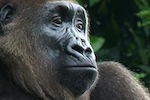
(10/28/2014) The Cross River Gorilla, the rarest and most threatened of gorilla subspecies, has reason to cheer. Last month, on September 29, the Prime Minister of Cameroon, Philemon Yang, signed a decree to officially create a new protected area – Tofala Wildlife Sanctuary – in the southwestern part of the country.
How protected are they? Report finds world’s Protected Areas may relax, shrink, even completely disappear (PART I)
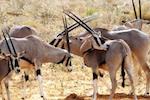
(10/28/2014) On March 1, 1872, the United States Congress declared 3,400 square miles of land spanning three states as the country’s – and the world’s – first national park. We call it Yellowstone. Today, there are over 160,000 PAs spanning 12.7 percent of the planet’s land surface.
Photos: slumbering lions win top photo prize
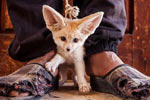
(10/27/2014) The king of beasts took this year’s top prize in the Wildlife Photographer of the Year competition, which is co-owned by the Natural History Museum (London) and the BBC. The photo, of female lions and their cubs resting on a rock face in the Serengeti National Park in Tanzania, was taken by Michael ‘Nick’ Nichols, a photographer with National Geographic.
Google’s new Gombe Street View lets users ‘walk’ along chimp trails and into Jane Goodall’s house
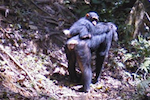
(10/24/2014) Google Maps is now available for Tanzanian forest paths. Users can walk virtually along the same trails Jane Goodall has used for her decades of chimpanzee monitoring — and even into her house.
Beef, palm oil, soy, and wood products from 8 countries responsible for 1/3 of forest destruction
(10/23/2014) Four commodities produced in just eight countries are responsible for a third of the world’s forest loss, according to a new report. Those familiar with the long-standing effort to stop deforestation won’t be surprised by the commodities named: beef, palm oil, soy, and wood products (including timber and paper). Nor will they be very surprised by most of the countries: Brazil, Indonesia, and Malaysia.
Demand for rhino horn drops 38 percent in Vietnam after advertising campaigns
(10/22/2014) A new poll finds that consumer demand for rhino horn in Vietnam has dropped precipitously following several advertising campaigns. According to the poll by the Humane Society International (HIS) and Vietnam CITES, demand has plunged 38 percent since last year.
Bats, Deforestation, Diseases, Ebola, Environment, Forests, Gfrn, Global Forest Reporting Network, Global Forest Watch, Green, Habitat Destruction, Habitat Loss, Mrn, Rainforests, Tropical Forests
Africa, Liberia
Source link : https://news.mongabay.com/2014/10/destroyed-habitat-fewer-resources-ebola-the-many-repercussions-of-liberias-deforestation/
Author :
Publish date : 2014-10-29 07:00:00
Copyright for syndicated content belongs to the linked Source.





